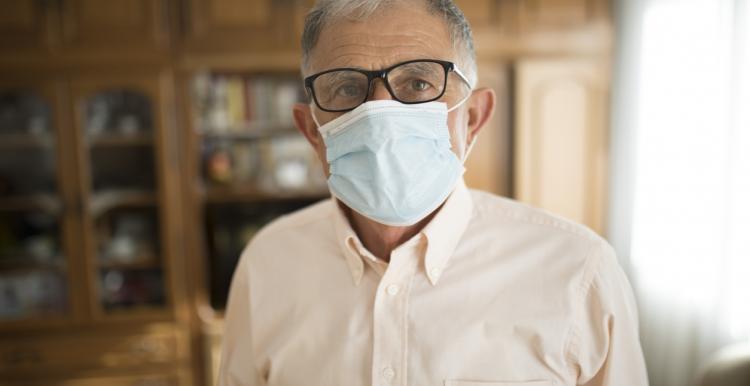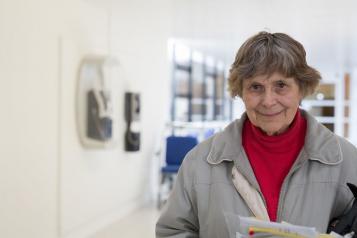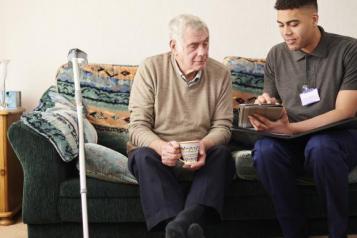COVID-19: What you need to know when visiting a care home

Last updated 7 January 2022
The Government has updated their advice on supporting safe visiting in care homes.
Key information
- If you live in a care home, you can select three named visitors and one essential care giver to visit you indoors.
- Every care home resident can nominate an essential care giver who can visit during an outbreak or period of isolation.
- Following a COVID-19 outbreak at a care home, visits will pause until the whole home has completed two rounds of negative PCR tests, taken four to seven days apart. This means outbreaks could be declared over in some homes after seven or eight days.
Go to full guidance
For the most up to date guidance, including information of what should be included in your care home’s visiting policy, visit the Gov.uk website.
See also the guidance for supported living settings.
Can I visit someone in a care home?
All care home residents can nominate three named visitors for indoor visits. Your care home will ask who you would like as your named visitors.
Every care home resident can also nominate an essential care giver, in addition to their three named visitors. Essential care givers can visit indoors more often, including during outbreaks or periods of self-isolation.
Where a resident lacks the capacity to choose an essential care giver, the care home should discuss the situation with the resident’s family, friends, attorney, deputy or anyone else who may usually have visited.
Indoor visits to a resident at the end of their life should continue in all cases, without limiting the number of visitors. This includes in the event of an outbreak.
For those not nominated as named visitors or essential care givers, visits can still be arranged outdoors, in designated visiting 'pods', behind windows, or substantial screens. Each care home will have its own arrangements for these types of visits.
Have you had problems visiting a loved one?
Tell us your experiences of visiting your loved ones in a care home and whether you have encountered any problems.
Do I need to take a test to visit a care home?
If you visit a care home resident as a named visitor, you must take a rapid lateral flow test and test negative before every visit.
The care home should provide full details on their testing process and obtain consent from visitors before they take part in testing. The guidance recommends that testing takes place on-site at the care home. However, visitors may also be able to self-test at home using test kits provided by the care home, the Government, or another lateral flow test site.
If visitors test positive, they will not be allowed into the home for a visit. They must instead follow government guidance on self-isolation. Visitors testing positive should also complete a further test, which will either be provided to them by the care home if testing on-site or ordered through the government website or by calling 119.
Essential care givers will have access to the same testing and PPE as care home staff. This includes one PCR test and three on-site lateral flow tests a week. If there is an outbreak in the home, essential care givers may be asked to take additional tests. However, visits cannot occur if the essential care giver or resident is COVID-19 positive unless this is for an end of life visit.
End of life visitors should be tested using lateral flow tests for indoor visits.
Can I visit a care home if a close contact tests positive for COVID-19?
Visitors who have been in close contact with someone who tests positive and are not legally required to self-isolate are advised against visiting the care home for ten days, unless absolutely necessary, even if they have been fully vaccinated.
Where visits do occur, visitors should have received a negative PCR test result prior to their visit, and a negative lateral flow test result earlier in the day of their visit
What should I do to keep the person I am visiting safe?
Vaccination is one of our best defences to combat infection. It significantly reduces the transmission of infection, particularly after two or more doses. The Government strongly recommends that residents and visitors receive two doses of the vaccine, plus their booster, before conducting visits.
If eligible, visitors are also advised to get their flu jab when it is offered to them.
It is advised to care homes that visitors should not enter the care home if they are feeling unwell, even if they have tested negative for COVID-19 and are fully vaccinated and have received their booster.
To reduce the risk of infection, it is also vital that visitors wash their hands regularly, use any PPE the home provides, and limit contact with residents and staff by maintaining as much social distance as possible.
How often can I visit a care home?
There is no nationally-set limit on how often a resident's three named visitors can visit the care home for indoor visits. However, visitors should make arrangements with the care home for a visit in advance, so that the care home can manage the number of people attending the home at any one time. This will help them to ensure visiting is safe, based on the layout of the home.
The care home should set out any precautions or limits in their visiting policy.
How do I find out the visiting policy of a care home?
The care home’s visiting policy should be made available and communicated to residents, and their loved ones, including named visitors and essential care givers.
Visitors can tell the care home their preferred communication method, so they can receive updates on visiting arrangements in the most appropriate format.
What happens if there is an outbreak at the care home?
In the event of outbreaks, it is recommended that indoor visiting be restricted, with only ‘end of life’ visits or visits from essential care givers recommended.
Visiting restrictions will continue until the care home has been assessed to be in recovery, this will likely be between seven and 14 days for most homes.
In the event of an outbreak, other visiting and communication arrangements should be provided between residents and their loved ones. This could include:
- Visits in well-ventilated spaces with substantial screens, visiting pods or from behind windows
- Telephone calls
- Video calls
- Newsletters
- Emails, letters, cards or photographs.
What happens if I can’t see my family or friend in the care home?
If you disagree with a care home's decision not to offer visiting or another decision, you should speak to the care home manager and discuss the home’s visiting policy and risk-assessment materials.
You can also contact the Care Quality Commission. They are responsible for inspecting the safety and quality of care provided in care homes.
Do you need help finding a care home?
Choosing a care home can be difficult. We have spoken to residents in care homes in Sunderland, their relatives, friends and staff to find out what it's like to live in a care home to help you make your decision.
Can a care home resident come and visit me out of the care home?
Yes, visits out of care homes can be allowed for residents of all ages. This could be for a short walk, to attend a place of worship or for a longer visit including an overnight stay to see family or friends.
If a resident is assessed as lacking the relevant mental capacity to decide to go out, the individual making decisions on their behalf should follow the ‘best interests checklist’ as set out under the Mental Capacity Act.
If care home residents have had at least two doses of the coronavirus vaccine (or are exempt), they will not have to isolate for 14 days after visits out of the home. Instead, they should take a lateral flow test every second day for 10 days following the visit out.
If a care home resident has not received at least two doses (or are exempt), they should not visit outside of homes unless they isolate for 14 days after the visit out.
Regardless of vaccination status, all residents will have to isolate for 14 days after visits out of the home if they have attended:
- Emergency or unplanned overnight stays in the hospital (residents do not need to isolate if they are returning from a planned hospital stay.
- Visits assessed to be high-risk following an individual risk assessment by the care home.
If a visit out is impossible without self-isolation on return because of COVID-19 risks, care homes should communicate the reasons for this decision to the resident and their loved ones.
In the event of an outbreak in a care home, the home will likely reduce opportunities for outward visiting (except in exceptional circumstances).
Read the guidance for visits out of care homes
The government have now published guidance for visits out of care homes. To find out more, please visit the Gov.uk website.


